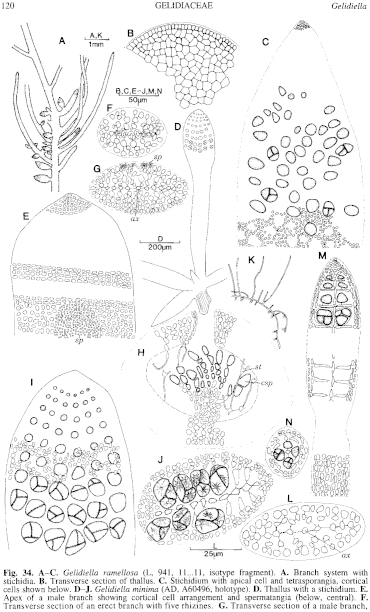|
|
|
|
|
|||||||||||
|
Electronic Flora of South Australia Species Fact Sheet
Phylum Rhodophyta – Class Florideophyceae – Order Gelidiales – Family Gelidiaceae
Thallus (Fig. 34D) red-brown, forming thin entangled mats 1–2 cm across, with prostrate, arching, branched stolons bearing erect axes 0.5–1.5 mm high; stolons and erect branches terete to compressed, 50–150 (–200) µm broad and 40–100 thick. Holdfasts peg-like, of massed rhizoids, 80–160 pin long and 40–80 µm in diameter, situated opposite a branch; epiphytic on crustose calcareous algae. Structure uniaxial with a slightly protruding apical cell (Fig. 34E). Outer cortical cells (Fig. 34E) more or less isodiametric, rounded to angular, more or less in lengthwise rows, protoplast (5–) 6–10 µm across with the wall 1.5–2.5 µm thick, rhodoplasts few per cell, discoid to laminate; hairs present near apices of erect branches. Cortex 2–3 cells thick, with inner cells in fairly regular lines lengthwise and slightly elongate; axial and secondary cells (Fig. 34F, G) forming a distinct transverse row of (5–) 6–11, thick walled cells, (2.5–) 4–6 µm in diameter and 30–40 µm long; rhizines absent (Fig. 34G) or very few (Fig. 34F) in some axes.
Reproduction: Reproductive organs subterminal on erect branches (300–) 800–1100 µm long. Sexual thalli monoecious and protandrous. Carpogonial branches unknown. Cystocarps (Fig. 34H) mature 200–250 µm from apices of erect branches, single, 240–320 µm across, unilocular, with a branched basal system of small cells forming chains of 2–3 sporangia maturing terminally, carposporangia ovoid to slightly angular, 20–35 µm in diameter, with a central stellate rhodoplast; slender arachnoid cells traverse from the base of the carposporophyte to the pericarp; ostiole prominent, 40–50 µm across. Spermatangia (Fig. 34E, G) formed in subterminal sori, initials replacing outer cortical cells in groups of 2 or 4, elongate, 1–2 µm in diameter, frequently persisting at base of mature cystocarps.
Tetrasporangia (Fig. 34I, J) in subterminal sod (160–) 200–250 (–300) µm broad and 300–500 (–1000) µm long, in regular acropetally developed rows of (4–) 6 (–7) sporangia of similar age, cut off on both sides of the axial cells and thus in two rows, subspherical to slightly ovoid, (23–) 30–45 µm in diameter, cruciately to irregularly divided, rhodoplast stellate.
Type from Point Lonsdale, Vic., 2.5–4 m deep (Kraft & van Amerongen, 1.iii.1989; holotype in AD, A60496, isotype in GALW, 8059).
Selected specimens: Topgallant I., S. Aust., 10 m deep on crustose coralline (0' Leary, 20.i.1992; AD, A61674). Wedge I., S. Aust., 8 m deep (0' Leary, 23.i.1992; AD, A61664). Cable Bay, Yorke Pen., S. Aust., 5–10 m deep (0' Leary, 22.vii.1992; AD, A61740).
Distribution: Topgallant I., S. Aust., to Point Lonsdale, Vic.
Taxonomic notes: This inconspicuous but distinctive species occurs on calcareous substrata (dead shells and living crustose coralline algae) in a similar manner to G. calcicola Maggs & Guiry (1987) from the British Isles and northern France, and like the latter shows very few rhizines in some sections. The only previous account of cystocarps in Gelidiella is that of Sreenivasa Rao & Trivedi (1986, p. 255) who illustrate the cystocarp of an unnamed species as unilocular with a single ostiole. The affinities of G. minima must await more comprehensive studies on generic distinctions in the Gelidiales.
References:
GUIRY, M.D. & WOMERSLEY, H.B.S. (1992). Gelidiella minima sp. nov. (Rhodophyta) from Victoria, Australia: implications for the generic classification of the Gelidiaceae. Br. phycol. J. 27, 165–176.
MAGGS, C.A. & GUIRY, M.D. (1987). Gelidiella calcicola sp. nov. (Rhodophyta) from the British Isles and northern France. Br. phycol. J. 22, 417–434.
SREENIVASA RAO, P. & TRIVEDI, M.K. (1986). Reproduction in Gelidiella. In Desikachary T.V. (Ed.), Taxonomy of Algae, pp. 255–260. (Univ. Madras: Madras.)
The Marine Benthic Flora of Southern Australia Part IIIA complete list of references.
Publication:
Womersley, H.B.S. (14 January, 1994)
The Marine Benthic Flora of Southern Australia
Rhodophyta. Part IIIA, Bangiophyceae and Florideophyceae (to Gigartinales)
Reproduced with permission from The Marine Benthic Flora of Southern Australia Part IIIA 1994, by H.B.S. Womersley. Australian Biological Resources Study, Canberra. Copyright Commonwealth of Australia.
Illustration in Womersley Part IIIA, 1994: FIG. 34 D–J.

Figure 34 enlarge
Fig. 34. A–C. Gelidiella ramellosa (L, 941, 11...11, isotype fragment). A. Branch system with stichidia. 13. Transverse section of thallus. C. Stichidium with apical cell and tetrasporangia, cortical cells shown below. D–J. Gelidiella minima (AD, A60496, holotype). D. Thallus with a stichidium. E. Apex of a male branch showing cortical cell arrangement and spermatangia (below, central). F. Transverse section of an erect branch with five rhizines. G. Transverse section of a male branch, showing axial cell, secondary transverse row and cortical cells; spermatangia on upper surface. H. Section of a cystocarp, showing carposporangia, elongate arachnoid cells and ostiole. I. Surface view of a stichidium with tetrasporangia. J. Cross section of a stichidium. K–N. Gelidiella antipai (AD, A59079). K. Thallus with stolon and erect branches. L. Cross section of branch showing axial cell, secondary row, and cortical cells. M. A stichidium (segments omitted at dashes) showing tetrasporangial whorls and cortical cells (below). N. Cross section of stichidium with a whorl of four tetrasporangia. [D, E, G–J also used in Guiry & Womersley 1992]

|
Email Contact: State Herbarium of South Australia |

|